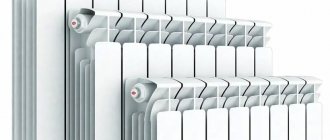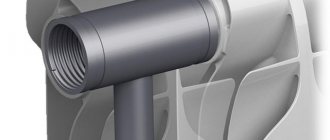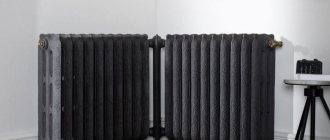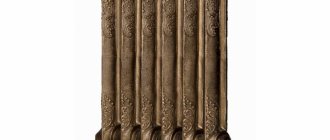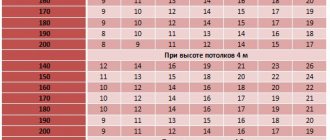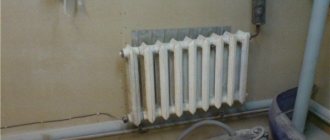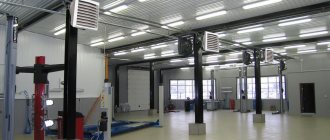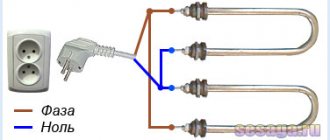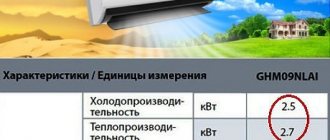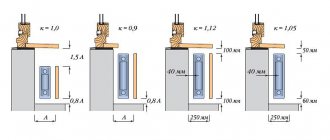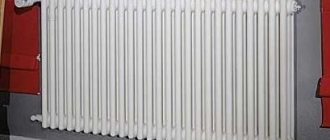How do foreign radiators differ from domestic ones?
The products of both groups of manufacturers are made from almost the same cast iron. The difference lies in the surface characteristics of the cast iron.
Foreign versions have a smooth inner surface . The coolant circulation easily slides along it without “feeling” much hydraulic resistance. Therefore, smaller sections of foreign heating devices are able to pass more water per unit of internal area and absorb more heat. As a result, their power increases. They need to be installed in rooms with a large area (30 or more sq. m.).
Power of classic radiators
MS-140 batteries are very popular. There are two modifications:
- MS-140-300.
- MS-140-500.
The sections of the first radiator model are smaller and are capable of delivering 0.106 kW.
The power of the segments of the second model is measured at 0.160 kW.
They are large in size and heavy. The large model has a section whose height and width are 0.588 x 0.121 m. The internal space volume of one segment is 1.5 liters.
Parameters of some battery samples
Comparative power of 1 section of radiators by imported and domestic manufacturers
In distant Soviet times, MS-140 batteries could be found in almost every apartment, but today they are perceived by many as a relic of the past. However, some users still prefer them to all other well-known models. Their admirers usually choose the following two modifications:
- in the first model, the power of 1 section of a cast iron radiator in kW is 0.120 units;
- for the second sample this figure is 0.190 kilowatts.
The latter are much larger in size and much heavier - the height and width of the sections are 0.588 and 0.121 meters, respectively. The volume of the internal cavities of one such segment is 1.5 liters.
Heat transfer of modern cast iron devices
very efficient in terms of heat transfer .
These devices for heating houses of different sizes have a section that produces 0.14 kW. The heating device Viadrus STYL 500 has this power. Its segment is almost twice as light and smaller than the section of the devices described above. One particle of such a cast iron device holds 0.8 liters of coolant.
Radiator sections of some Russian manufacturers have a similar volume. They are capable of delivering heat at 0.102 kW. According to this indicator, they lag behind Czech products, but are better than MS-140.
The simplest calculation of battery power
To calculate the power of the device required to heat a room with an area of 25 m2 , you need:
- Determine the volume of the room. To do this, 25 m2 must be multiplied by the height of the room, for example, 2.5 m. The resulting figure is 62.5 cubic meters.
- The result obtained must be multiplied by a special coefficient. It depends on the type of room. If this is a panel house, then it is 0.041 kW per 1 cubic meter: 62.5 x 0.041 = 2.562 kW - the total power of the device for a room with an area of 25 m2.
Next, you need to divide the total heat transfer by the power of the segment: 2.562/0.14 = 18.3 – the number of battery sections required to heat a room with an area of 25 m2. The resulting figure must be rounded up. You need to buy a battery with 19 sections. You can purchase two batteries with the number of segments that add up to 19.
The coefficient specified in the second step depends on the type of house. This indicator could be like this:
- 0.034 kW/m – for houses built of brick;
- 0.02 kW/m – for houses whose construction was carried out in compliance with modern standards.
More complicated way
It involves the use of two indicators:
- Total heat demand.
- Heat transfer from one radiator fin (this value can be taken from the technical documentation).
When determining the first indicator, it is necessary to take into account:
- Room area.
- Floor.
- Ceiling height (whether it exceeds 3 m or not).
- Availability of air conditioning and fireplace.
- Number and area of windows.
- Availability of insulation of walls, floor and ceiling.
The heat requirement is determined in the following sequence:
- Calculate the volume of the room (area multiplied by height).
- The volume is multiplied by the figure 41 W (according to SNIP, 41 W of heat should be created per 1 cubic meter).
- The resulting figure is adjusted by various coefficients:
- if the ceiling is less than 3 m, then the height is divided by 3 and the result obtained is multiplied by the calculated heat requirement. If more, then they do the same;
- if the room is corner, then the resulting figure is multiplied by 1.8;
- if there is one large window or several windows, then the result is again multiplied by 1.8. In the case of plastic double-glazed windows, a correction factor of 0.8 is used;
- if the battery is connected to the bottom, then take a correction factor of 1.1;
At the end, the resulting figure is divided by the heat transfer of the section and the number of fins is determined.
poluchi-teplo.ru
Three step instructions
The salesman at the Plumbing and Heating store was taken aback: “You need 26 ribs for the room.” By this time I had 10 cast iron fins, and although they did not heat up enough, I understood that 26 fins of an aluminum radiator for a room of 18 square meters was too much. The seller either made a mistake or wanted me to be very, very warm. I didn’t check the seller’s calculations, but rummaged through the reference literature and found a simple and effective method for calculating the number of radiators, regardless of what type they are: copper convectors, aluminum or metal panels.
Let's carry out the calculation using an example: There is a room with an area of 12 square meters 4 (m) * 3 (m) and a height of 2.7 meters (standard room in a Soviet-built high-rise building): The first thing you need to know for the calculation is the volume of your room. We multiply the length and width by the height (in meters) (4 * 3 * 2.7) - and we get the number 32.4. This is the volume of the room in cubic meters. Second : to heat one cubic meter in a house of standard construction (without metal-plastic windows, foam insulation, etc. energy-saving measures) in the climatic conditions of Ukraine, Belarus, Moldova and the European part of Russia, including Moscow and Nizhny Novgorod, 41 watts of thermal power is required . Let's find out how much heat we need by multiplying our (your) volume V by the number 41: V* 41 = 32.4 * 41 W = 1328.4 W. The resulting figure is the amount of heat that the radiators must give off to heat your room. Let’s round it up to 1300. But how can we “scratch” the number of radiators from this figure?
It’s very simple: any radiator has information about the thermal power on the packaging or in the included insert. Thermal power is the amount of heat that a radiator is capable of delivering when cooled from heating temperature to room temperature - 20 degrees Celsius. Every seller of a specialized store must know the power of batteries and fins, or you can easily find it on the Internet for the model you are interested in. Manufacturers usually overestimate the thermal power of their products; I will talk about the refined calculation in the next post. For now, we are interested in the approximate number of radiators. In our case, we can limit ourselves to a steel panel radiator with a power of 1300 W. However, what if it suddenly becomes VERY COLD outside?
For reliability, it is worth increasing the resulting figure by 20 percent. To do this, multiply 1300 by a factor of 1.2 - we get 1560. They don’t sell radiators of this power, so we’ll round the figure down - to 1500 W or 1.5 kilowatts. That's it, this is the number we need. A radiator of any type: bimetallic, aluminum, cast iron, steel, white with specks and black with stripes will provide us with heating of the room in any frost possible in our latitudes, if it produces 1500 watts of heat. For example, the typical power of an aluminum or bimetallic radiator fin with a height of about 60 centimeters is 150 watts. So we will need 10 edges. Similarly - for standard cast iron radiators type MS-140. To find out the number of heating devices for the entire apartment, we carry out the calculation for each room separately. If the apartment is “cold” , with a large number of windows, thin walls, on the first or last floor, etc., 47 watts per cubic meter will be needed for heating, therefore, in the calculations we substitute this figure instead of 41. If it is “warm” , with metal-plastic windows, insulation of floors and walls, in a house built using modern insulating materials - we take 30 W. And finally, the simplest method of calculation: If you had standard cast iron radiators about 60 centimeters high in your room before replacing, and you felt warm with them, feel free to count their number and multiply by 150 W - you will find out the required power of the new ones. If you plan to choose aluminum ribs or bimetal, you can buy them on the basis of one cast iron rib - one haluminium rib.
If batteries interfere with your appearance or you don’t want to be a fireman, you can choose XL PIPE underfloor heating systems (without complex wiring and a boiler)
Right choice
- The performance of heating devices should be 10% of the area of the room if its ceiling height is less than 3 m.
- If it is higher, then 30% is added.
- For the end room you need to add another 30%.
Necessary calculations
After determining the heat losses, you need to determine the performance of the device (how many kW should be in a steel radiator or other devices).
- For example, you need to heat a room with an area of 15 m² and a ceiling height of 3 m.
- We find its volume: 15∙3=45 m³.
- The instructions say that to heat 1 m³ in the conditions of central Russia you need 41 W of thermal output.
- This means that we multiply the volume of the room by this figure: 45∙41=1845 W. The heating radiator must have this power.
Note! If the home is located in a region with severe winters, the resulting figure must be multiplied by 1.2 (heat loss coefficient). The final figure will be 2214 watts.
Number of ribs
Next, you need to calculate the number of sections in the battery. The instructions for the products indicate the parameter of each edge.
From it you will find out how many kW are in one section of a bimetallic radiator and an aluminum analogue - this is 150-200 W. Let's take the maximum parameter and divide the total required power in our example by it: 2214:200=11.07. This means that to heat the room you need a battery of 11 sections.
Thermal power
In the room, heating devices are placed against the outer wall under the window opening. As a result, the heat emitted by the device is distributed optimally. The cold air coming from the windows is blocked by the heated air flowing upward from the radiator.
Cast iron batteries
Cast iron analogues have the following advantages:
- have a long service life;
- have a high level of strength;
- they are resistant to corrosion;
- Excellent for use in utility systems operating on low-quality coolant.
- Now manufacturers produce cast iron batteries (their price is higher than conventional analogues), which have an improved appearance thanks to the use of new technologies for casting their housings.
Disadvantages of products: large mass and thermal inertia.
The lower table states how many kW is in a cast iron radiator, based on its model.
| Radiator model | Thermal power of one section in Watts |
| MS-140/M-2 | 160 |
| MS-140/M-300 | 117 |
| MS-90 | 130 |
| T-90/M | 127 |
Note! To heat a room with an area of 15 m², the power, that is, kW of a cast iron radiator, must be at least 1.5. In other words, the battery should consist of 10-12 sections.
Aluminum radiators
Aluminum products have greater thermal power than cast iron counterparts. When asked how many kW is in one section of an aluminum radiator, experts answer that it reaches 0.185-0.2 kW. As a result, for the standard level of heating of a fifteen-meter room, 9-10 sections of aluminum sections will be sufficient.
The advantages of such devices:
- a light weight;
- aesthetic design;
- high level of heat transfer;
- You can control the temperature yourself using thermostatic valves.
But aluminum products do not have the same strength as their cast iron counterparts, for example a 2 kW oil radiator. Therefore, they are sensitive to surges in operating pressure in the system, water hammer, and excessively high temperature of the coolant.
Note! When water has a high pH (acidity) level, aluminum releases a lot of hydrogen. This negatively affects our health. Based on this, it is advisable to use such devices in a heating system in which the coolant is neutrally acidic.
Bimetallic products
Before you find out how many kW are in 1 section of a bimetallic radiator, you should take into account that such batteries have similar operational parameters to their aluminum counterparts. However, they do not have any inherent disadvantages.
This circumstance was determined by the design of the devices.
- They consist of copper or steel pipes through which coolant flows.
- The tubes are hidden in an aluminum plate housing. As a result, the water circulating inside does not interact with the aluminum of the case.
- Based on this, the acidic and mechanical characteristics of the coolant do not in any way affect the operation and condition of the device.
Thanks to the steel pipes, the device has high strength. Increased heat transfer is ensured by external aluminum fins. When trying to find out how many kW is in a steel radiator, keep in mind that bimetal has the highest heat transfer - about 0.2 kW per fin.
Power calculation
What does it depend on?
- Room area - in order for a radiator to effectively heat a given volume, it must have a certain heat output, which directly depends on the number of sections included in it. Power is calculated in the standard way: 1 kW - per 10 m² of room, respectively - 100 W are required per 1 m².
Table of power of cast iron heating radiators depending on model
Now the instructions recommend determining the area of the room itself and calculating how much heat transfer the radiator must have to maintain the set air temperature.
- Factors - however, not everything is so simple, and the above calculation is approximate; various nuances that affect heat loss should be taken into account:
| Contact of two walls with the street | In this case, heat loss will increase, so the power of the heating device or devices should be higher than average. |
| Door and window openings | Affects the penetration of outside air into the room. The material from which they are made also plays a role. |
Advice: the radiator’s heat transfer should be calculated taking into account all the negative factors that involve the penetration of cold air into the room.
- To find out the heat transfer of one heating device, you should know the power of the MS 140 cast iron radiator section and add up their number . This figure is standard for most manufacturers and is equal to 150 W, but depending on the shape and quality of the device, it may vary slightly.
Type of cast iron heating device MS-140
Coolant
Another indicator that needs to be taken into account is the temperature of the circulating fluid.
Therefore, the standard section power takes into account two temperature indicators:
- indoor mode;
- temperature inside the heating system, depending on the degree of heating of the coolant.
Three-channel ChMZ models
Thermal energy power is determined by the difference between these indicators. And if at a coolant temperature of 70 °C the difference was 50, we can say that the power of 1 section of the MS 140 cast iron radiator is exactly 150 W.
First of all, this is due to the fact that it is the temperature regime that is taken into account in which a constant air temperature in the room will always be maintained at 20°C. In addition, heating of the coolant occurs taking into account the properties of cast iron, which do not have high heat transfer rates.
Easy way to calculate
If everything is complicated with the calculations, you can resort to a simpler method and benefit from many years of experience for those who already use such radiators. For a room of 15 m² you will need a 10-section radiator.
However, it should be noted that the room must have one window. For each subsequent one, you will need to add more sections, the number depends on the design of the window opening itself, the material from which it is made, the number of cameras in the double-glazed window and other factors. But, as a rule, 1 or 2 more sections are added, as a result the price of the equipment increases.
Tip: when the area of the room exceeds 20 m², there should be several radiators. Moreover, they must be installed in different places, since even by increasing a certain number of sections, the situation will not improve.
Heat transfer depends directly on the choice of installation location of the device
Main qualities of cast iron radiators
Heat is released by heating devices in two ways:
- convection;
- radiant energy.
They are capable of creating a thermal curtain, which is why it is recommended to install them under windows, where the cold comes from.
However, the power of one section of the MS 140 cast iron radiator is not the main indicator of the device’s reliability. For example, aluminum and bimetallic radiators have greater heat transfer, but their service life is much shorter.
Perhaps this is the reason why cast iron models are still in demand. Agree, you won’t find aluminum batteries in any ancient building, but there are plenty of cast iron batteries installed in past centuries.
The opinion of many people agrees that the large amount of coolant required for them is very uneconomical and leads to excessive consumption of energy required to heat it. But this is just a misconception; the more coolant a device contains, the more heat it gives off.
New models easily fit into any interior and decorate it
In addition, if for some reason the coolant supply is stopped, the cast iron battery will retain heat transfer for a long time, which is explained both by the properties of the material and the large volume of hot water it contains. The only drawback of the devices is their high inertia, which contributes to too slow heating; all other problems are completely solvable.
Calculation by area
This is the simplest method that allows you to roughly estimate the number of sections required to heat a room. Based on many calculations, standards for the average heating power of one square area have been derived. To take into account the climatic features of the region, two standards were prescribed in SNiP:
- for regions of central Russia, from 60 W to 100 W are required;
- for areas above 60°, the heating rate per square meter is 150-200 W.
Why are the standards given such a wide range? In order to take into account the wall materials and the degree of insulation. For houses made of concrete, the maximum values are taken; for brick houses, average values can be used. For insulated houses - minimal. Another important detail: these standards are calculated for the average ceiling height - no higher than 2.7 meters.
Knowing the area of the room, multiply its heat consumption rate, which is most suitable for your conditions. You get the total heat loss of the room. In the technical data for the selected radiator model, find the thermal power of one section. Divide the total heat loss by the power, and you get the amount. It’s not difficult, but to make it clearer, let’s give an example.
An example of calculating the number of radiator sections by room area
Corner room 16 m2, in the middle zone, in a brick house. Batteries with a thermal power of 140 W will be installed.
For a brick house, we take heat loss in the middle of the range. Since the room is corner, it is better to take a larger value. Let it be 95 W. Then it turns out that heating the room requires 16 m2 * 95 W = 1520 W.
Now we count the quantity: 1520 W / 140 W = 10.86 pcs. Round up, it turns out to be 11 pieces. This is how many radiator sections will need to be installed.
The calculation of heating radiators per area is simple, but far from ideal: the height of the ceilings is not taken into account at all. For non-standard heights, a different technique is used: by volume.
We count batteries by volume
SNiP also has standards for heating one cubic meter of premises. They are given for different types of buildings:
- for brick, 1 m3 requires 34 W of heat;
- for panel - 41 W
This calculation of radiator sections is similar to the previous one, only now we need not an area, but a different volume and standards. We multiply the volume by the norm, divide the resulting figure by the power of one section of the radiator (aluminum, bimetallic or cast iron).
Example of calculation by volume
For example, let’s calculate how many sections are needed for a room with an area of 16 m2 and a ceiling height of 3 meters. The building is made of brick. Let's take radiators of the same power: 140 W:
- Finding the volume. 16 m2 * 3 m = 48 m3
- We calculate the required amount of heat (the norm for brick buildings is 34 W). 48 m3 * 34 W = 1632 W.
- We determine how many sections are needed. 1632 W / 140 W = 11.66 pcs. Round up, we get 12 pieces.
Now you know two ways to calculate the number of radiators per room.
Heat transfer of one section
Today there is a wide range of radiators. While most are similar in appearance, thermal performance may differ significantly. They depend on the material from which they are made, on the dimensions, wall thickness, internal cross-section and on how well the design is thought out.
Therefore, it is possible to say exactly how many kW in 1 section of an aluminum (cast-iron bimetallic) radiator only in relation to each model. This data is provided by the manufacturer. After all, there is a significant difference in size: some of them are tall and narrow, others are low and deep. The power of a section of the same height from the same manufacturer, but of different models, may differ by 15-25 W (see the table below STYLE 500 and STYLE PLUS 500). There may be even more noticeable differences between different manufacturers.
However, for a preliminary assessment of how many battery sections are needed for space heating, we calculated the average thermal power value for each type of radiator. They can be used for approximate calculations (data are given for batteries with an interaxial distance of 50 cm):
- Bimetallic - one section produces 185 W (0.185 kW).
- Aluminum - 190 W (0.19 kW).
- Cast iron - 120 W (0.120 kW).
More precisely, how many kW can you have in one section of a bimetallic, aluminum or cast iron radiator when you choose a model and decide on the dimensions. The difference in cast iron batteries can be very big. They are available with thin or thick walls, which causes their thermal output to change significantly. Above are the average values for batteries of the usual shape (accordion) and those close to it. Retro-style radiators have significantly lower thermal output.
Based on these values and average standards in SNiP, the average number of radiator sections per 1 m2 was calculated:
- the bimetallic section will heat 1.8 m2;
- aluminum - 1.9-2.0 m2;
- cast iron - 1.4-1.5 m2;
How to calculate the number of radiator sections using this data? It's still simpler. If you know the area of the room, divide it by the coefficient. For example, a room of 16 m2, to heat it you will need approximately:
- bimetallic 16 m2 / 1.8 m2 = 8.88 pcs, rounded - 9 pcs.
- aluminum 16 m2 / 2 m2 = 8 pcs.
- cast iron 16 m2 / 1.4 m2 = 11.4 pcs, rounded up - 12 pcs.
These calculations are only approximate. Using them, you can roughly estimate the costs of purchasing heating appliances. You can accurately calculate the number of radiators per room by choosing a model, and then recalculating the number depending on the temperature of the coolant in your system.
Calculation of radiator sections depending on real conditions
Once again, please note that the thermal power of one battery section is indicated for ideal conditions. This is how much heat the battery will produce if its coolant temperature at the inlet is +90°C, at the outlet +70°C, and the room is maintained at +20°C. That is, the temperature pressure of the system (also called “delta system”) will be 70°C. What to do if your system does not exceed +70°C at the inlet? or do you need a room temperature of +23°C? Recalculate the declared power.
To do this, you need to calculate the temperature pressure of your heating system. For example, at your supply you have +70°C, at your outlet 60°C, and in the room you need a temperature of +23°C. Find the delta of your system: this is the arithmetic average of the inlet and outlet temperatures, minus the room temperature.
For our case it turns out: (70°C+ 60°C)/2 - 23°C = 42°C. The delta for such conditions is 42°C. Next, we find this value in the conversion table (located below) and multiply the declared power by this coefficient. Let's learn the power that this section can produce for your conditions.
We find in the columns tinted blue a line with a delta of 42°C. It corresponds to a coefficient of 0.51. Now we calculate the thermal power of 1 radiator section for our case. For example, the declared power is 185 W, applying the found coefficient, we get: 185 W * 0.51 = 94.35 W. Almost twice as much. This is the power that needs to be substituted when calculating the radiator sections. Only taking into account individual parameters will the room be warm.
stroychik.ru
Cast iron radiators are still one of the most common means of heating in domestic apartments. They can deservedly be called veterans of the heating front - after all, this type of heating devices was invented back in 1857 by the French scientist Franz San Galli. Since then, they have been widely used for heating rooms and are still relevant today.
The popularity of cast iron batteries is explained very simply - they are convenient, efficient and low in cost.
What is heat transfer and power of radiators
The power of cast iron heating radiators and their heat output are among the main characteristics of any device that provides room heating. Typically, manufacturers of equipment for heating structures indicate this parameter for one section of the battery, and the required number is calculated based on the size of the room and the required heat transfer of cast iron radiators.
In addition, other factors are taken into account, such as the volume of the room, the presence of windows and doors, the degree of insulation, climatic conditions, etc. The heat output of heating radiators depends on the material they are made of. It should be noted that cast iron is inferior to aluminum and steel in this matter. The thermal conductivity of this material is 2 times lower than that of aluminum. But this drawback is compensated by the low inertia of cast iron, which gains heat and releases it for a long time.
In closed heating systems with forced circulation, the efficiency of aluminum batteries will be much greater, but subject to the presence of an intense coolant flow. As for open structures, cast iron has more advantages with natural circulation.
The approximate power of one section of a cast iron radiator is 160 watts, while for aluminum and bimetallic devices the same parameter is within 200 watts. Therefore, under equal operating conditions, a cast iron battery should have a large number of sections.
Main types
Cast iron radiators M-140
Radiators type M-140 have a fairly simple design and are easy to maintain. The material used in their manufacture is cast iron. It is highly resistant to corrosion processes and can be used with any coolant. The low level of hydraulic pressure allows the use of radiators for both gravitational and forced coolant circulation systems. The high threshold of resistance to hydraulic shocks allows them to be used in both two-story and nine-story buildings. The advantages of the M-140 are ease of maintenance, reliability, long service life and low cost.
Cast iron radiators MS-140-500
They are widely used for heating buildings with a coolant temperature within 1300C and a pressure of 0.9 MPa. The capacity of one cavity is 1.45 liters, the volume of the heated area is 0.244 square meters. The material used for the manufacture of sections is SCh-10 (gray cast iron).
Cast iron radiators MS-140-300
Radiators used to heat rooms with low window sills and a pressure of 0.9 MPa. Cavity capacity - 1.11 l. The weight of the cavity including components is 5700 g. The strength of the calculated heat flow is 0.120 kW.
Cast iron radiators MS-140M-500-09
Radiators of this model are used for different rooms with a coolant temperature of up to 1300C and a pressure of 0.9 MPa. The mass of one cavity is 7100 g. The material used for manufacturing is gray cast iron. S heating with one cavity - 0.244 m2.
Important! When choosing a radiator for your home, be sure to pay attention to its characteristics and make all kinds of calculations in advance, since it will be almost impossible to exchange the purchased product.
Advantages and disadvantages of cast iron batteries
Like any heating devices, cast iron radiators have both advantages and disadvantages. The advantages include:
- Resistance to chemically active components contained in coolants. Unlike materials used in the production of other types of radiators, cast iron practically does not rust.
- Long service life. Some cast iron batteries that have served for 50-60 years are still functioning today.
- There is no need to connect a circulation pump, since cast iron radiators create little hydraulic resistance for the coolant.
- Do not require cleaning for a long time due to the large diameter of the channels;
- Thermal inertia, which acts as an advantage and a disadvantage at the same time. Radiators can retain heat for a long time, but temperature control is not possible.
Pros and cons of using cast iron radiators
Any heating system that exists today has both pros and cons, let’s look at them.
The rated thermal power of each section is 160W. Approximately 65% of the released heat flux heats the air accumulating in the upper part of the room, and the remaining 35% warms the lower part of the room.
Pros:
- Long period of use, ranging from 15 to 50 years.
- High level of resistance to corrosion processes.
- Possibility of use in heating systems with gravitational circulation of coolant.
Minuses:
- Low efficiency of heat transfer index correction;
- High level of labor intensity during installation;
Important! In order not to encounter problems during installation, be sure to take into account the above-mentioned pros and cons of cast iron radiators. Their installation is not cheap, and repeated installation work will require a lot of financial resources.
prokommunikacii.ru
What you need to know when choosing aluminum batteries
Aluminum radiators are very sensitive to the acidic environment in the heating system. Therefore, reliable, long-term operation is only possible at a pH of 6.5... 8.
You should also know that:
- the internal surface must be carefully processed, an oxide film must be applied;
- the radiator must have a passport with the characteristics specified in it, it is desirable that there is a test report;
- factory assembly is more reliable, so if possible, you should buy a ready-made battery from the required number of sections;
- You should not install a battery of more than 15 sections, it is better to install two;
- an unusual radiator design may impair its performance;
- Chinese-made NF/68 radiators should be avoided. They may contain asbestos, which is hazardous to health.
What you need to know about radiator power?
The heat transfer of a radiator depends on the temperature of the coolant and the air in the room. The greater this difference, the better it transfers thermal energy.
Manufacturers often claim inflated technical specifications. They show power for a temperature difference of 65-70 °C. But in reality the temperature difference is 35-50 degrees.
Therefore, if you see in the instructions the thermal power of a section of 200 W at ΔT = 70, in reality it is 150-160 W (ΔT indicates the temperature difference).
Knowing the real power value, you can calculate the required number of sections in an online calculator.
How to choose a cast iron radiator - selection parameters
The main selection criterion is the thermal power produced by the device.
Each model is characterized by a certain amount of released thermal energy. Its quantity is largely influenced by the color of the coating. Black-colored products emit 25% more thermal energy than white-colored ones.
When choosing a cast iron radiator, you should also pay attention to the installation method, connections, permissible coolant temperatures and pressure.
How many kW in one section of an aluminum radiator
The thermal power of an aluminum radiator section depends on the volume of water contained in it. Standard volumes are 0.35 and 0.5 l.
Aluminum batteries give off heat 50-60% by radiation and 40-50% by convection. The air cutter enhances convection by 20-25%, which increases heat transfer.
At an air temperature of 20-24 °C and water temperature in the circuit of 65-70 °C, the thermal power of one aluminum section is:
- Volume 0.35 l., without cut-off – 0.1-0.12 kilowatts;
- Volume 0.35 l., with cut-off – 0.12-0.13 kilowatts;
- Volume 0.5 l., without cut-off – 0.155-0.170 kilowatts;
- Volume 0.5 l., with cut-off – 0.170-0.200 kilowatts.
It is difficult to name the exact amount of heat transfer - it depends on the design features, the diameter of the pipes, and the thickness of the fins. Performance is affected by the type of battery connection, water pumping speed, and contamination of internal surfaces.
How many kW in one section of a cast iron radiator
The heat output of a cast iron radiator depends on the volume of water, wall thickness, presence of fins, height and width of the section. There are several standard models of cast iron batteries, the declared heat transfer of one section of which is:
- MS-140 – 175 W;
- MS 140-500 – 195 W;
- MS 140-300 – 120 W;
- MS 110-500 – 150 W;
- MS 100-500 – 135 W;
- MS 90-500 – 140 W.
In the classification, the first number indicates the width of the vertical cast iron channel, the second - its height.
Modern cast iron batteries differ from standard MS brand products. They may have other sizes and designs; there are models with air cutoffs. Manufacturers claim the performance of one section ranges from 150 to 220 W.
If thermal power indicators are given for a temperature difference ΔT of 60-70 degrees, they differ from the real ones.
For batteries with a water temperature of 55-60 °C, the actual performance will be 75-85%, for batteries with a water temperature of 65-70 °C - about 85-90% of that specified in the manufacturer’s specifications.
Design features of cast iron radiators
Cast iron devices are made from cast iron alloy, which has high strength and is homogeneous.
Battery sections are produced separately by casting, then connected to obtain devices of the required thermal power. Sealing of connections is achieved using sealing elements made of various materials.
There are three types of design of cast iron radiators: single-channel, two-channel and three-channel.
The principle of operation is very simple, it is as follows: the heated coolant circulates inside the device, gives off heat to its walls, which is then transferred to the surrounding air.
- Heating equipment of this type is characterized by the following features:
- Internal fins are vertically positioned to increase the heat transfer surface;
- Good strength and ability to withstand high pressures;
- Relatively low coefficient of linear expansion of the material and high heat resistance;
- Thermal power ranges from 100 to 150 W;
- A high degree of inertia of products, due to which their heating and cooling occurs rather slowly, thermoregulation is practically meaningless.
How many kilowatts are in one section of a bimetallic radiator
Bimetallic radiators are difficult to distinguish from aluminum ones in appearance. They can also be equipped with air cutoffs, and the level of heat transfer mainly depends on the height.
As with aluminum, manufacturers' specifications differ from those in reality. Therefore, we provide information for the water temperature in the circuit of 65-70 degrees.
Thermal power of a section of a bimetallic heating radiator without air cutoffs:
- 200 mm – 0.5-0.6 kW;
- 350 mm – 0.1-0.11 kW;
- 500 mm – 0.14-0.155 kW.
How many kW of one section of a bimetallic radiator with air cutoffs:
- 200 mm – 0.6-0.7 kW;
- 350 mm – 0.115-0.125 kW;
- 500 mm – 0.17-0.19 kW.

